This pub is closed permanently. Your nearest Wetherspoon pub: The White Hart
This grade II listed building has an early-to-mid-19th-century façade. The third floor (with dormer windows) was added in 1919. Remains of large internal beams, discovered during recent renovations, indicate that the building dates from medieval times. The Bell was mentioned in the 15th century, when Market Square had several inns or taverns.
Illustrations and text about John Wilkes.
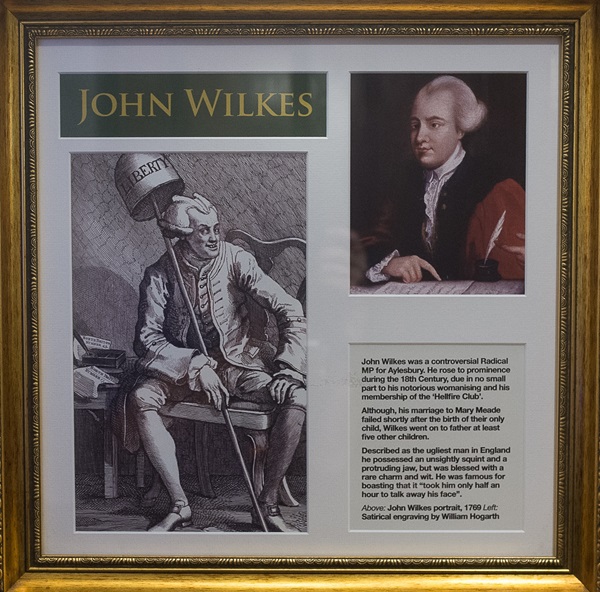
The text reads: John Wilkes was a controversial Radical MP for Aylesbury. He rose to prominence during the 18th century, due in no small part to his notorious womanising and his membership of the Hellfire Club.
Although, his marriage to Mary Meade failed shortly after the birth of their only child, Wilkes went on the father at least five other children.
Described as the ugliest man in England he possessed an unsightly squint and a protruding jaw, but was blessed with a rare charm and wit. He was famous for boasting that it “took him only half an hour to talk away his face”.
Above: John Wilkes portrait, 1769
Left: Satirical engraving by William Hogarth.
An illustration, photographs and text about Market Square.
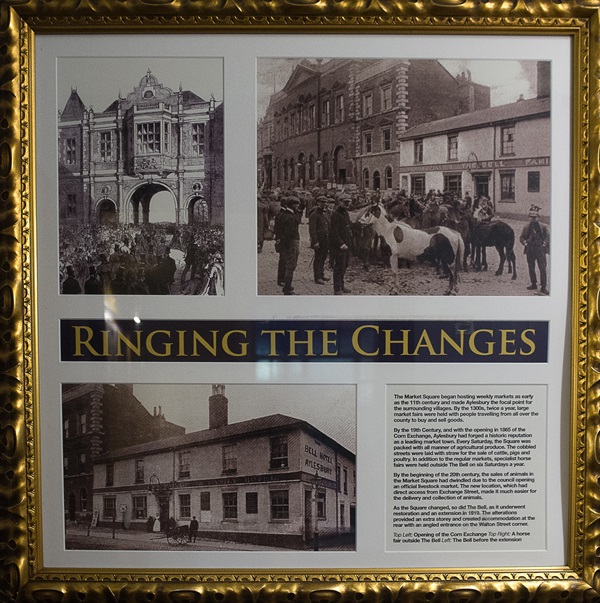
The text reads: The Market Square began hosting weekly markets as early as the 11th century and made Aylesbury the focal point for the surrounding villages. By the 1300s, twice a year, large market fairs were held with people travelling from all over the county to buy and sell goods.
By the 19th century, and with the opening in 1865 of the Corn Exchange, Aylesbury had forged a historic reputation as a leading market town. Every Saturday, the square was packed with all manner of agricultural produce. The cobbled streets were laid with straw for the sale of cattle, pigs and poultry. In addition to the regular markets, specialist horse fairs were held outside The Bell on six Saturdays a year.
By the beginning of the 20th century, the sales of animals in the Market Square had dwindled due to the council opening an official livestock market. The new location, which had direct access from Exchange Street, made it much easier for the delivery and collection of animals.
As the Square changes, so did The Bell, as it underwent restoration and an extension in 1919. The alterations provided an extra storey and created accommodation at the rear with an angled entrance on the Walton Street corner.
Top left: Opening of the Corn Exchange
Top right: A horse fair outside The Bell
Left: The Bell before the extension.
Photographs and text about the road to freedom.
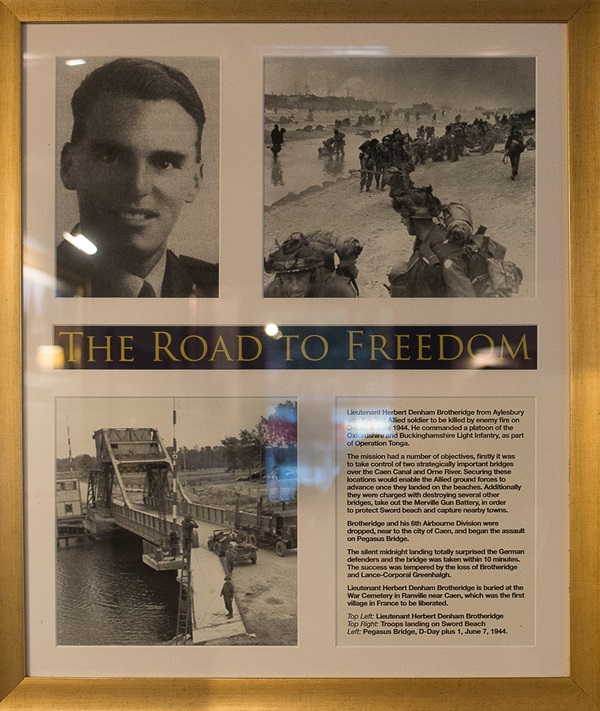
The text reads: Lieutenant Hebert Denham Brotheridge from Aylesbury was the first allied soldier to be killed by enemy fire on D-Day, 6 June 1944. He commanded a platoon of the Oxfordshire and Buckinghamshire Light Infantry, as part of Operation Tonga.
The mission had a number of objectives, firstly it was to take control of two strategically important bridges over the Caen Canal and Orne River. Securing these locations would enable the allied ground forces to advance once they landed on the beaches. Additionally they were charged with destroying several other bridges, take out the Merville Gun Battery, in order to protect Sword beach and capture nearby towns.
Brotheridge and his 6th airborne division were dropped, near to the city of Caen, and began the assault on Pegasus Bridge.
The silent midnight landing totally surprised the German defenders and the bridge was taken within 10 minutes. The success was tempered by the loss of Brotheridge and lance-corporal Greenhalgh.
Lieutenant Herbert Denham Brotheridge is buried at the War Cemetery in Ranville near Caen, which was the first village in France to be liberated.
Top left: Lieutenant Herbert Denham Brotheridge
Top right: Troops landing on Sword Beach
Left: Pegasus Bridge, D-Day plus 1, June 7, 1944.
Photographs, illustrations and text about Waddesdon Manor.

The text reads: Baron Ferdinand de Rothschild was born in Paris on the 17 December 1839.
He was a member of the Rothschild banking dynasty and became a British subject after studying at Trinity College, Cambridge.
In 1874, the baron bought an estate near the village of Waddesdon in Buckinghamshire and between 1874 and 1889 built Waddesdon Manor. He employed the architect Gabriel- Hippolyte Destailleur. The towers at Waddesdon were based on those of the Chateau de Maintenon, and the twin staircase towers, on the north façade, were inspired by the staircase tower at the Château de Chambord.
Waddesdon’s 16th century styling belies its modern innovations, for beneath the exterior is a load bearing steel frame, which allowed upper floors to have a completely different layout to the ground floors. It also boasted electric lighting which was of such fascinations to Queen Victoria that she spent 10 minutes turning a chandelier on and off. Baron Ferdinand also embellished the property with his extensive collection of tapestries, furniture, ceramics and paintings.
From 1883, Ferdinand Rothschild became the high sheriff of Buckinghamshire and in 1885 was elected as Liberal MP for Aylesbury, a seat that he held until his death at Waddesdon Manor in 1868.
The baron’s sister, Alice de Rothschild, was bequeathed the property and she added to his art collections as did the last Rothschild to live at Waddesdon, James de Rothschild, who donated the manor, its grounds and all of its contents to the National Trust in 1957.
Left: Waddesdon Manor
Below left: Baron Ferdinand de Rothschild
Below right: The Waddesdon Parterre.
Photographs and text about Mentmore Towers.
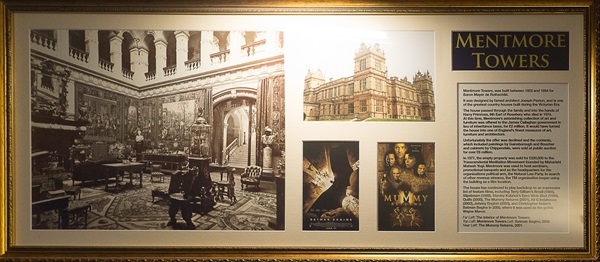
The text reads: Mentmore Towers was built between 1852 and 1854 for baron mayor de Rothschild.
It was designed by famed architect Joseph Paxton, and is one of the greatest country houses built during the Victorian era.
The house passed through the family and into the hands of Harry Primrose, 6th earl of Roseberry who died in 1974. At this time, Mentmore’s astonishing collection of art and furniture was offered to the James Callaghan government in lieu of inheritance taxes, for £2 million. In would have turned the house into one of England’s finest museums of art, furniture and architecture.
Unfortunately the offer was declined and the contents, which included paintings by Gainsborough and Boucher and cabinets by Chippendale, were sold at public auction for over £6 million.
In 1977, the empty property was sold for £220,000 to the Tran
Photographs and text about local fundraising.
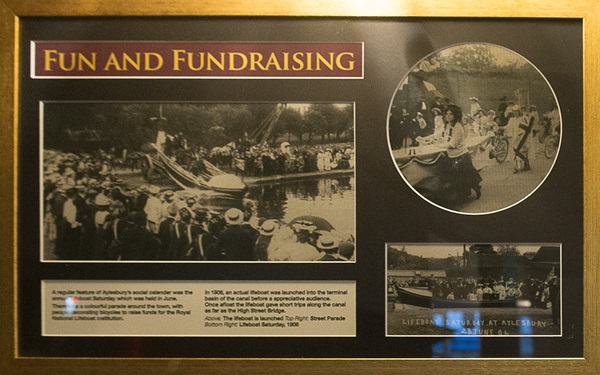
The text reads: In 1906, an actual lifeboat was launched into the terminal basin, of the canal before an appreciative audience. Once afloat the lifeboat gave short trips along the canal as far as the High Street Bridge.
Above: The lifeboat is launched
Top right: Street Parade
Bottom right: Lifeboat Saturday, 1906.
External photograph of the building – main entrance.
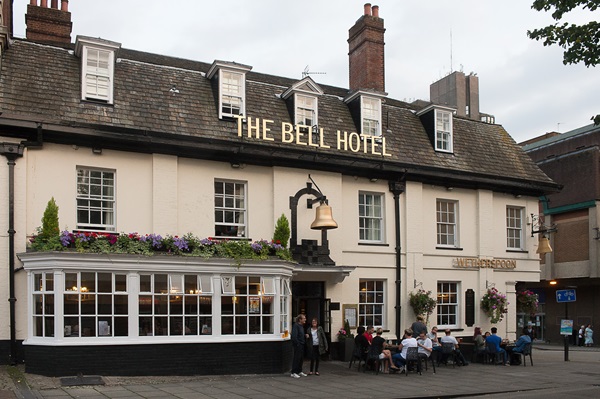
If you have information on the history of this pub, then we’d like you to share it with us. Please e-mail all information to: pubhistories@jdwetherspoon.co.uk